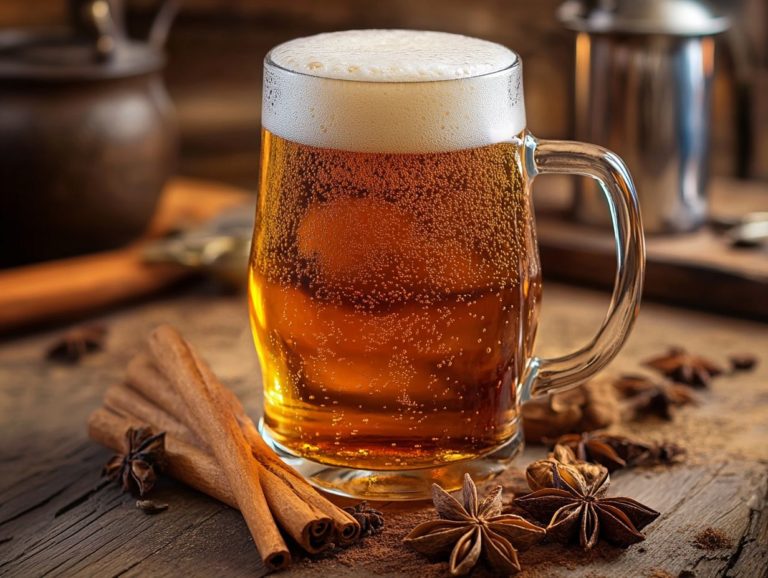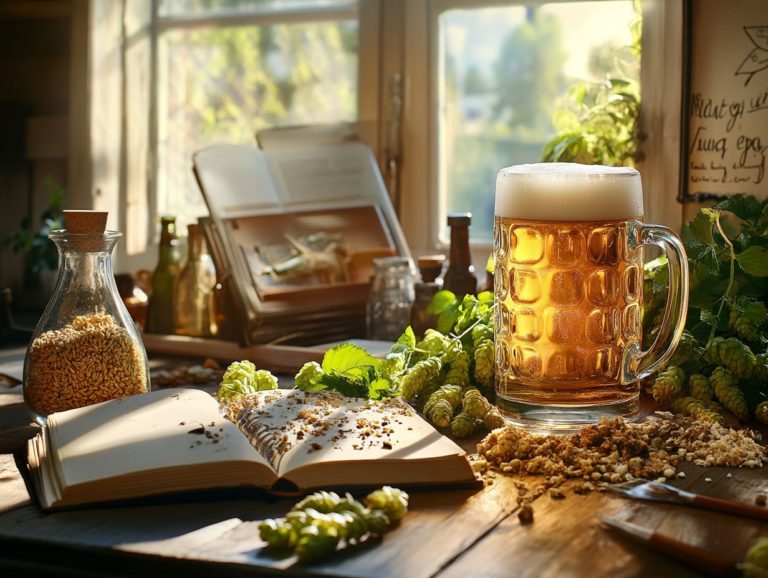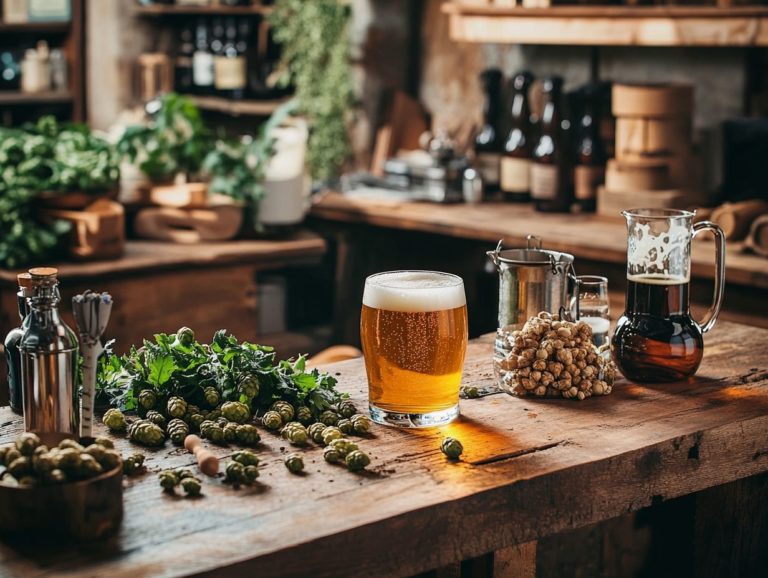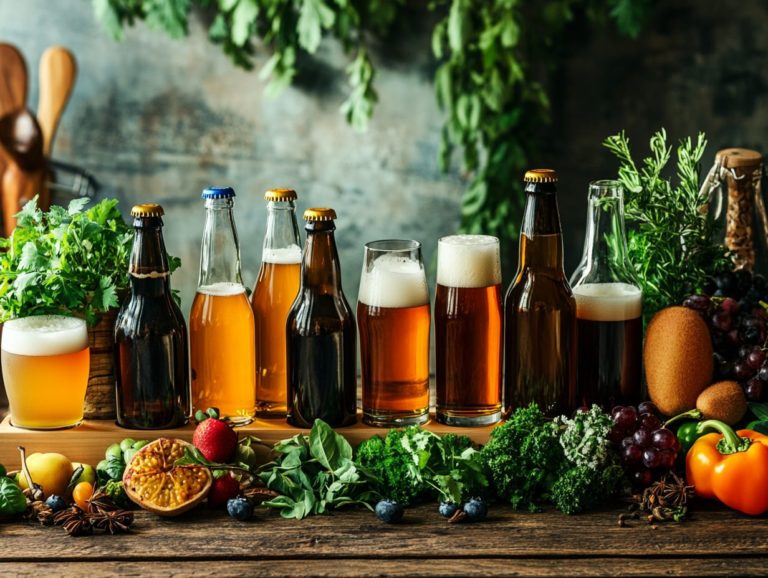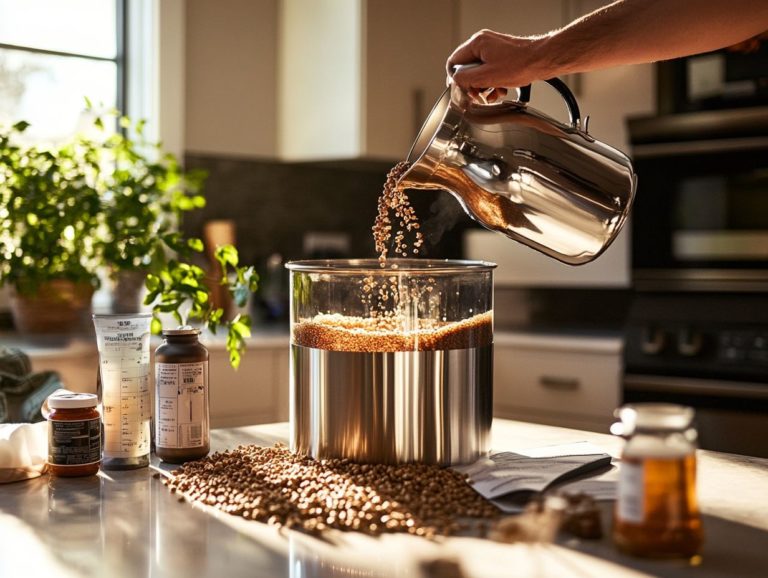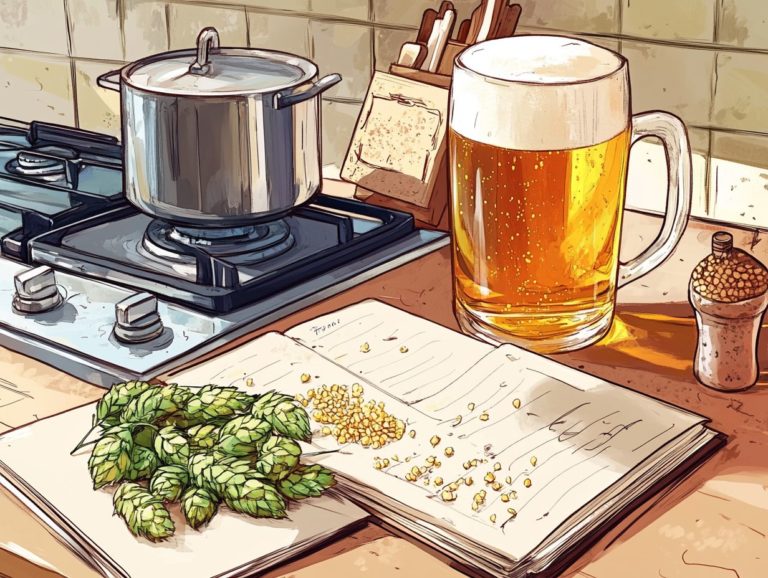How to Experiment with Beer Recipes at Home
Crafting your own beer can be a truly rewarding and creative adventure. Whether you’re brewing your first homebrew or refining your fermentation process, each step is an opportunity to learn and grow.
Whether you’re just starting out or you ve already mastered the art of homebrewing, experimenting with beer recipes gives you the chance to explore a world of flavors, styles, and techniques tailored to your palate. Homebrewing allows you to craft unique tastes and discover the endless possibilities within the world of beer brewing.
This guide will walk you through the essential ingredients needed for brewing, various beer styles to consider, and valuable tips for experimenting safely and effectively. You will also discover common pitfalls to avoid, helping to ensure that your brewing journey is both enjoyable and successful. From understanding the basics of brewing techniques to exploring hop varieties, we cover everything you need to know.
Get ready for your next thrilling brewing adventure, whether it’s a simple American wheat ale or a complex Belgian wheat!
Contents
- Key Takeaways:
- Introduction to Beer Brewing
- Essential Ingredients for Beer Brewing
- Hops
- Yeast
- Understanding Beer Styles
- How to Choose the Right Style for Your Experiment?
- Basic Steps for Experimenting with Beer Recipes
- Essential Homebrewing Tips for Crafting Delicious Beer
- How to Experiment with Beer Recipes at Home
- Frequently Asked Questions
- What is the best way to start experimenting with beer recipes at home?
- Can I modify existing beer recipes, or do I need to create my own from scratch?
- How do I keep track of my beer recipes and experiments?
- What should I consider when experimenting with beer recipes?
- Is it necessary to have a lot of brewing experience to experiment with beer recipes at home?
- Are there any resources or communities for homebrewers looking to experiment with beer recipes?
Key Takeaways:
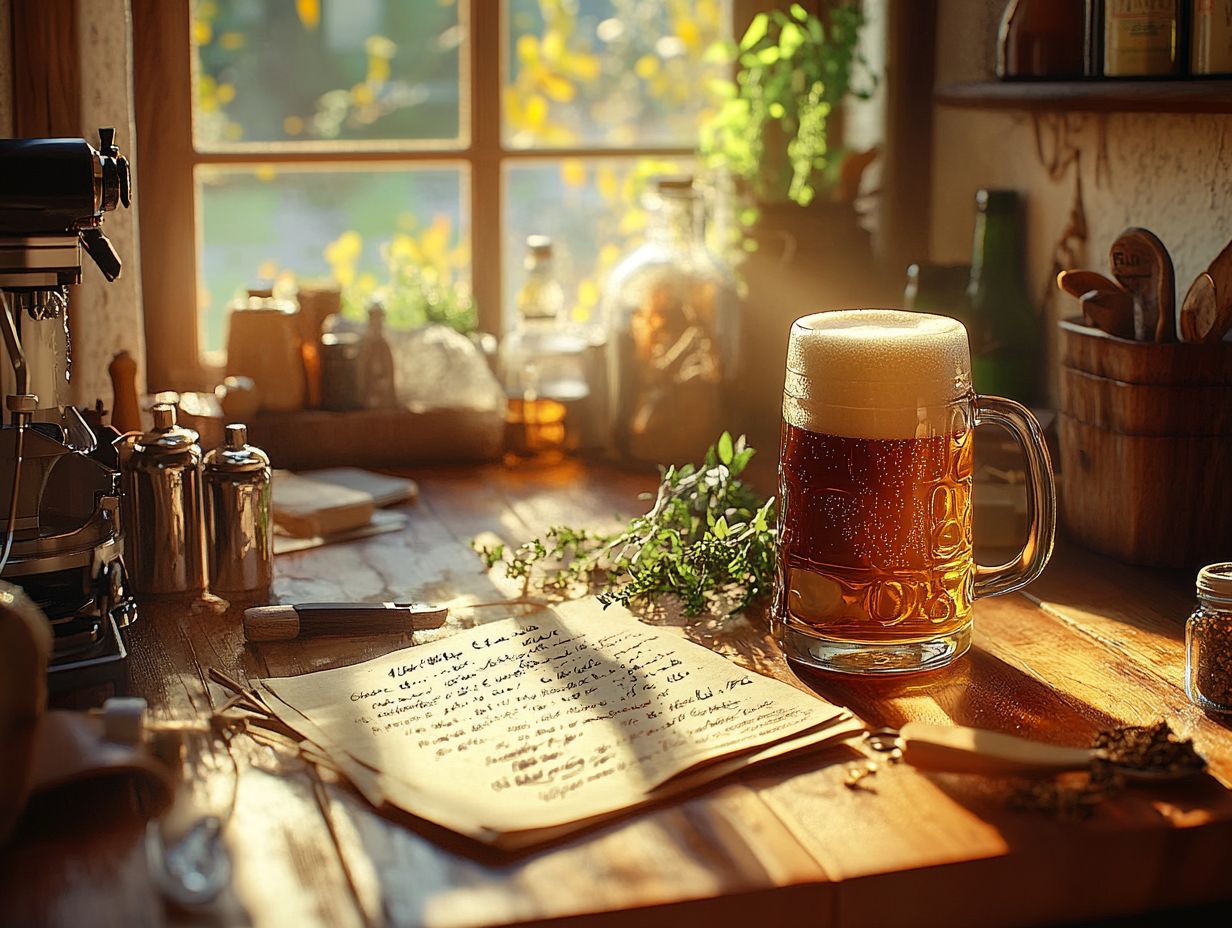
- Start small and keep detailed notes to track your experiments, including gravity readings and fermentation times.
- Choose the right beer style for your experiment and use quality ingredients, such as Maris Otter base malt or Cascade hops.
- Avoid common mistakes such as improper sanitation, incorrect yeast usage, and not controlling fermentation temperature and time.
What is a Beer Recipe?
A beer recipe is your carefully crafted blueprint for homebrewing, detailing all the vital elements you need for the perfect batch, from the original gravity to the final fermentation vessel. It covers everything from ingredient selection to brewing techniques and the specific steps in the brewing process. Think of it as your personal guide to achieving the flavors and aromas you desire, elevating the overall taste and experience of your beer.
Each recipe typically includes precise measurements for hops, malt, and yeast, along with important notes on fermentation times and temperatures to help ensure your success. This can range from simple brewing techniques to more advanced methods like dry hopping or oak aging.
Whether you’re diving into a traditional style or crafting a unique blend, grasping the components of a beer recipe is essential for creating exceptional homebrew.
Take hops, for example; they can introduce not just bitterness but also a dazzling array of flavors, from floral notes to zesty citrus, significantly shaping your beer’s overall aroma. Using different hop varieties like Cluster hops or Willamette hops can further diversify your brewing experience.
The various types of malt you choose will lend sweetness, color, and body to your brew, playing a crucial role in balancing out that hop bitterness. And let s not overlook yeast it plays a vital role in fermentation, transforming sugars into alcohol while generating flavors called esters and phenols, which add interesting notes and depth to your beer.
Beyond simply sticking to a structured brewing process, allowing a dash of creativity can spark your desire to experiment with different ingredient combinations, such as spices, herbs, or fruits like watermelon and apples, leading to innovative beer styles that might just astonish even the most experienced connoisseurs.
Introduction to Beer Brewing
Experimenting with beer recipes is a thrilling way for you to unlock your creativity and delve into the intricacies of homebrewing. You can try split batches to see how different variables like yeast strains or hop varieties affect your brew. It allows you to craft unique flavors that reflect your personal tastes and inspirations.
Whether you’re exploring new hop varieties, fine-tuning the types of malts used in your beer, or adding fruits like watermelon or apples, this journey of experimentation encourages innovation and deepens your understanding of the brewing process.
What starts as a simple recipe can evolve into complex experiments that not only challenge your skills but also provide an excellent canvas for trial and error. This experience enhances your brewing capabilities and connects you with a vibrant community of craft beer enthusiasts.
As you play with a range of ingredients think spices, herbs, or even unconventional additions like coffee or chocolate you may discover unexpected flavor combinations that elevate your creations. This trial and error approach can lead to delightful surprises and unique tastes.
Thoughtfully combining these ingredients can yield delightful surprises; for instance, a hint of orange peel can lighten an otherwise rich stout.
Keeping a brewing journal proves invaluable during this creative endeavor. Documenting each brew s components and results allows you to track your successes and refine your techniques over time. In the end, the pursuit of new flavors and styles not only brings you personal satisfaction but also infuses each brewing session with excitement and curiosity.
Essential Ingredients for Beer Brewing
The essential ingredients for beer brewing are the building blocks that shape the character and quality of your final product, playing a pivotal role in defining the beer’s overall taste, aroma, and appearance. From water and grains to hops and yeast, each element contributes to the complexity of your beer.
By understanding each component water, grains, hops, and yeast you equip yourself with the knowledge necessary to craft your desired brew style, whether it s an American wheat ale or a more intricate Belgian wheat.
Each ingredient interacts during the brewing process through fermentation (the process where yeast converts sugars into alcohol), leading to unique flavor combinations and aromas that can beautifully complement or intriguingly contrast with one another. Mastering these essential ingredients is crucial for you to create successful homebrew recipes that will impress your palate and those of your friends.
Water
Water serves as the cornerstone of beer, making up roughly 90% of the final product. Understanding its mineral content can help you achieve the desired profile for different beer styles. Its mineral content is not just a footnote; it plays a pivotal role in shaping the overall taste and quality of your brew.
This vital ingredient provides the foundation for the beer and significantly influences its mouthfeel, bitterness, and aroma. Different brewing styles necessitate specific mineral profiles to capture their unique flavor characteristics. For example, a hoppy IPA thrives on sulfate-rich water to amplify its crispness, while a malty stout calls for a higher chloride content to create that velvety smoothness.
Grasping how to adjust water parameters is essential for brewers who aspire to replicate classic beer styles or venture into uncharted flavor territories. This knowledge enables you to unlock the full potential of your ingredients and techniques, elevating your brewing game to new heights.
Grains
Grains, especially malt, are the essential foundation of any beer recipe, supplying the sugars needed for fermentation while also shaping the beer’s flavor, color, and body. From base malts like Maris Otter to specialty malts such as honey malt, each plays a crucial role.
Each type of grain plays a unique role in the brewing process. For instance, base malts like Maris Otter are vital; they not only deliver fermentable sugars but also lay the groundwork for the beer’s flavor profile, often bringing forth biscuity or nutty undertones. In contrast, specialty malts such as honey malt introduce layers of complexity, infusing sweetness and richness into the brew.
By thoughtfully selecting a combination of these malts, you can expertly craft the final beer profile, influencing everything from the aroma to the mouthfeel. This meticulous approach ultimately allows you to create a beverage that truly resonates with the desired style and appeals to your palate.
Hops
Hops play a crucial role in your beer brewing journey, offering not just the necessary bitterness to balance the sweetness of the malt but also an impressive spectrum of flavors and aromas that elevate the overall tasting experience. Brewing software can help you keep track of the alpha acids in your hop varieties, ensuring you hit the correct bitterness levels.
As you explore different hop varieties, you’ll discover how each one contributes its own unique touch to your brews. For example, Cascade hops are celebrated for their floral and citrus notes, making them a favored choice for American Pale Ales. On the other hand, Willamette hops bring earthy and spicy characteristics to the table, often gracing traditional styles with a gentle bitterness and a complex aromatic profile.
Don t overlook Cluster hops, one of the oldest varieties, known for their robust bitterness and subtle fruity aroma, which adds depth to darker beers and lagers. Each hop variety sparks creativity and allows you to craft unique flavors that cater to diverse palates and preferences, ensuring a vibrant and rich diversity in the world of craft beer.
Yeast

Yeast is the remarkable organism that works its magic in the fermentation process of beer brewing, transforming sugars from the malt into alcohol and carbon dioxide while also delivering the unique flavors and aromas that characterize each beer style. Different yeast strains like Safale US-05 and Belgian Wheat 3942 can dramatically influence your brew’s final taste.
Among the variety of yeast strains available, each one plays a pivotal role in shaping your brew’s final character. For instance, Safale US-05 is a favored choice among homebrewers for its clean, well-balanced profile, allowing the malt and hop characteristics to shine without overwhelming them. In contrast, Belgian Wheat 3942 introduces delightful fruity and spicy complexity, enhancing wheat beers with its distinctive esters.
By exploring these unique yeast strains, you can experiment with and refine your fermentation processes, ultimately crafting a diverse range of taste experiences that will elevate your brewing game.
Understanding Beer Styles
Understanding beer styles is crucial for you as a homebrewer. It enables you to appreciate the diverse array of flavors, aromas, and characteristics that different beers can offer from the crisp, refreshing notes of an American wheat ale to the intricate fruity complexity of a Belgian wheat. Familiarizing yourself with the Beer Judge Certification Program (BJCP) guidelines can help you craft beers that meet competitive standards.
The BJCP offers a structured framework for categorizing these styles, guiding you in refining your recipes according to established standards. By immersing yourself in the world of beer styles, you can experiment more effectively with ingredients and techniques, crafting brews that not only satisfy your palate but also captivate a broader audience.
Writing for a brewing blog or entering a beer competition can also provide valuable feedback and recognition for your efforts. What s your favorite beer style to brew?
Exploring Different Beer Styles
You ll discover a vast array of beer styles, each defined by its own unique flavors, aromas, and brewing techniques, with guidelines set forth by respected organizations like the BJCP, a cornerstone in the beer industry.
This remarkable diversity is not merely a celebration of rich brewing histories from various cultures; it also serves as an invaluable roadmap for homebrewers eager to craft their own distinctive beverages. By understanding different beer styles like the bold and hoppy India Pale Ale, the smooth and rich Stout, or the crisp and refreshing Lager you ll find yourself enabled to experiment with ingredients and techniques that resonate with your personal tastes.
Knowing the origins of these styles will deepen your appreciation for the craftsmanship behind each recipe, ultimately enhancing both your brewing experience and the quality of your creations.
How to Choose the Right Style for Your Experiment?
Choosing the right beer style for your brewing experiment is crucial for achieving those coveted flavor and aroma profiles. It all starts with a solid grasp of the various styles at your disposal. Consulting a beer recipe database can be a helpful starting point.
As you contemplate which style to brew, take a moment to reflect on your personal preferences. Are you in the mood for a light, citrusy ale, or does a rich, malty stout sound more enticing right now? Perhaps a SMaSH (Single Malt and Single Hop) recipe suits your experiment for simplicity.
It s also wise to consider seasonal trends. For example, an apple juice-based brew might be perfect for autumn. Lighter, fruitier beers can be incredibly refreshing during the summer months. Meanwhile, heavier, spiced varieties offer a comforting embrace when it’s chilly outside.
Don’t overlook the ingredients you currently have on hand. They can significantly guide your decision. Certain hops, malts, and ingredients that go well together have a natural affinity for specific styles. Cascade hops, Willamette hops, and Cluster hops each bring unique flavors to your brew.
To elevate your brewing experience further, think about experimenting with ingredients that go well together. For instance, incorporating chocolate malt in a stout can create a delightful contrast with coffee notes. This can result in a brew that truly captivates the senses.
Basic Steps for Experimenting with Beer Recipes
The fundamental steps for experimenting with beer recipes act as your blueprint. They expertly guide you through the enchanting process of creating exciting new beer recipes. Whether you re using brewing software like BeerSmith or following guidelines from the BJCP style handbook, these steps ensure a successful brewing journey.
By embracing the principles of trial and error alongside your creativity, you ll find yourself on a rewarding journey of homebrewing discovery.
1. Start with a Simple Recipe
Starting with a simple recipe is an excellent way to familiarize yourself with the brewing process. It helps in building a solid foundation for your future experiments. Base recipes such as a basic American Wheat Ale can serve as a great starting point.
By mastering this initial formula, you can gradually explore various modifications. Consider altering hop varieties, adjusting the fermentation temperature, or experimenting with different types of grains. Each ingredient plays a crucial role in shaping the final flavor profile and mouthfeel of your brew.
Understanding these nuances will enable you to innovate with confidence. As you progress, you ll find opportunities to tweak the recipe to suit your personal tastes or seasonal availability.
This transformation turns the brewing journey from merely following instructions into a canvas for your creative expression and hands-on learning.
2. Make Small Batches
Creating small batches during your brewing process offers you the freedom to experiment with flavors and techniques. This is without the pressure of committing to a larger volume. Split batches allow you to try different hop varieties or yeast strains in parallel, minimizing waste and allowing for more frequent trials.
This flexibility nurtures your creativity. It encourages you to explore new ingredients like unique hops or specialty malts that you might hesitate to incorporate into a full-sized batch.
With these smaller quantities, you can refine your recipes over time. Adjust variables such as fermentation temperatures or boil times based on the outcomes of each trial.
As you dive into these small batches, you’ll uncover what truly excites your palate! You’ll discover what aligns best with your taste preferences and skill levels. This ultimately leads to a more personalized and gratifying brewing experience.
Experimenting with dry hopping or oak aging can further enhance your small batch trials. This method also enables quicker turnaround between batches, enhancing your learning and adaptability in the craft.
Now it s time to get brewing! Dive into your next recipe and let your creativity flow.
Essential Homebrewing Tips for Crafting Delicious Beer
3. Keep Detailed Notes
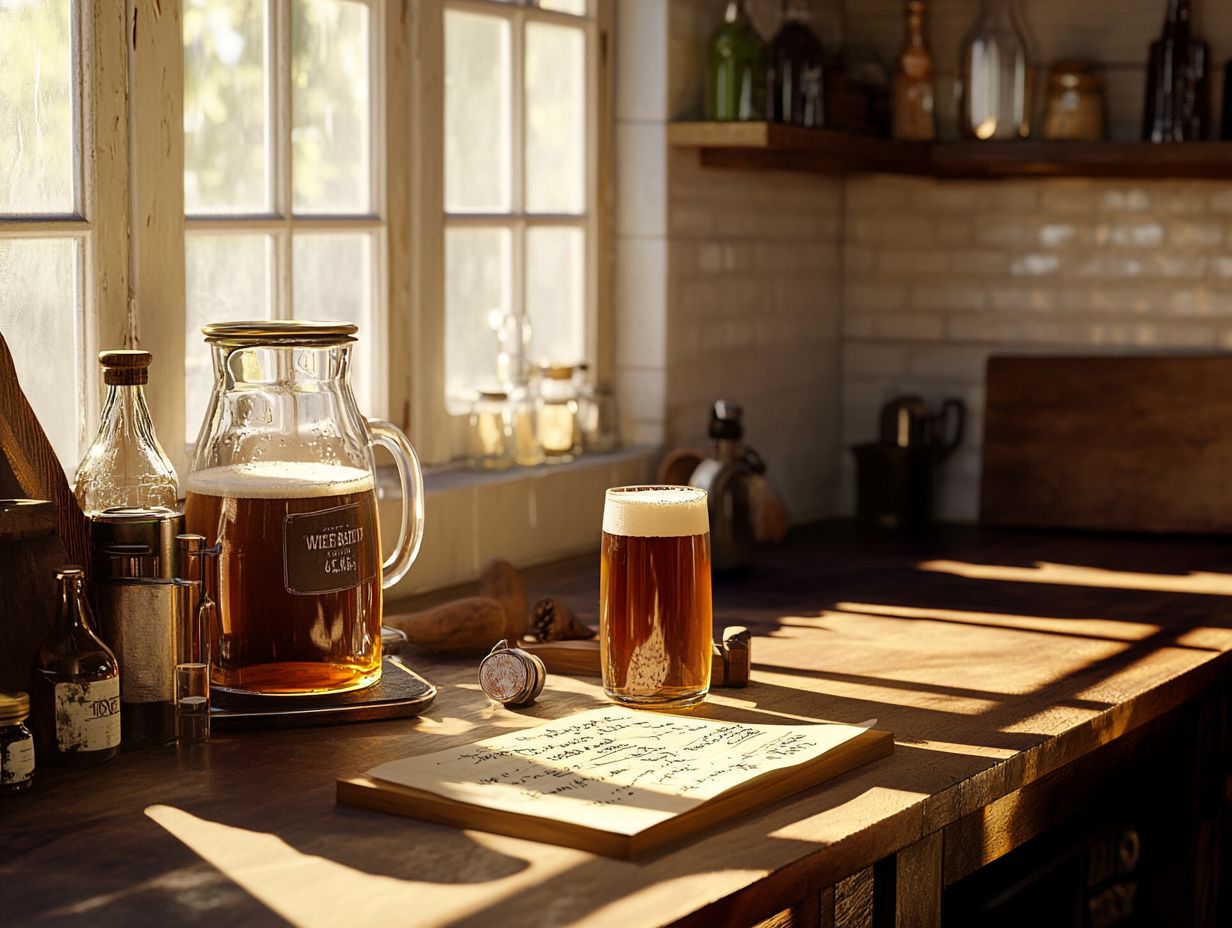
Keeping detailed notes during your brewing process is essential. It helps you track variables, results, and observations, which is beneficial for those who embrace a trial-and-error approach.
Documenting each stage from selecting your ingredients to fermentation and bottling creates a valuable resource for refining your techniques. Recording specific measurements of sugar content at different stages can provide insights into fermentation. This practice helps you identify how ingredients, temperatures, and timings affect your final product.
Maintaining such records not only deepens your understanding of brewing but also lets you replicate successful batches and experiment intelligently with new flavors. This disciplined approach elevates the quality of your beer while enriching your overall brewing experience.
4. Experiment with One Variable at a Time
When experimenting with beer recipes, change only one variable at a time. This method allows you to accurately assess its impact on the final product, simplifying your evaluation of results. Bryan Roth, a noted beer blogger from Durham, North Carolina, discusses the value of controlled experimentation.
This strategy clarifies how each element influences flavor, aroma, and overall quality. For example, if you adjust the hop quantities, keep all other ingredients consistent to pinpoint shifts in bitterness or aroma.
Experimenting with different yeast strains can also reveal unique character traits in your finished beer. Yeast options like Safale US-05, Wyeast 1056, and Fermentis each bring something distinct to your brew. Remember to maintain the same fermentation temperature to isolate the yeast s impact. Altering fermentation times can provide insights into how maturation affects taste, helping you draw conclusions about optimal brewing practices.
5. Use Quality Ingredients
Using quality ingredients is crucial in homebrewing, as they shape the flavors and aromas of your final beer and affect your enjoyment. Ingredients like Maris Otter malt or Belgian Wheat 3942 yeast can significantly enhance your brew.
When you prioritize sourcing high-quality hops, malt, and yeast, the brewing process becomes an art form, leading to a superior product. Selecting specific hop varieties can impart unique floral or citrus notes that enhance a pale ale or IPA. Your choice of malt adds sweetness and color and improves the mouthfeel and body of the beer.
To achieve your desired outcomes in homebrew recipes, explore local suppliers for fresh ingredients that can make a remarkable difference. Different yeast strains can unlock diverse fermentation profiles, reflecting your brewing intent. For example, Weihenstephan Weizen 3068 yeast can add unique banana and clove notes. Emphasizing ingredient selection ensures every brew becomes a delightful exploration of your craftsmanship.
Common Mistakes to Avoid
To craft successful and flavorful beer, avoid these common mistakes. Even minor oversights can dramatically affect fermentation and the final product. Subscribing to Zymurgy magazine provides regular tips to help steer clear of pitfalls.
Pay attention to the details, and your efforts will yield a brew that truly stands out. Get ready to elevate your brewing game and start brewing today using these essential tips!
1. Not Sanitizing Properly
Not properly sanitizing is one of the most critical missteps you can make as a homebrewer. It risks contamination that could ruin an otherwise perfect batch.
Sanitation is the bedrock of successful brewing. It ensures that unwanted bacteria and wild yeasts don’t interfere with the fermentation process. To effectively sanitize your equipment, such as carboys and fermentation vessels, consider using solutions like Star San or Iodophor. These are efficient and user-friendly, making them ideal for homebrewers.
Membership in the National Homebrew Competition can offer additional resources on sanitation. By thoroughly cleaning and rinsing all your brewing tools and surfaces, you can create a pristine environment that fosters yeast happiness. Don’t risk your brew! Skipping this step can turn your masterpiece into a disappointing batch, causing off-flavors, sourness, or even spoiled beer.
2. Using Too Much or Too Little Yeast
Using too much or too little yeast can greatly affect your fermentation process. It may lead to undesirable off-flavors or a stubborn fermentation that doesn’t produce the alcohol you desire.
Adjusting the original gravity and understanding how it impacts yeast requirements is essential. If you’re aiming for a specific beer style, getting the yeast measurement just right is crucial. Each style has its own ideal yeast quantity, which can fluctuate depending on factors like original gravity and batch size.
Tools like BeerSmith can help you calculate the precise yeast needed for your recipes. For higher gravity beers, you may need to use more yeast to guarantee an active fermentation, while lighter styles might require less. To determine the perfect amount, consider the yeast’s attenuation rate (the ability of yeast to convert sugars into alcohol) and viable cell count (the number of living yeast cells).
It’s also advantageous to use online yeast calculators, which take these variables into account. This way, you can ensure a cleaner and more flavorful final product that truly showcases your brewing skill and enhances your homebrew experience.
3. Not Controlling Fermentation Temperature
Not controlling fermentation temperature is a common pitfall that can lead to undesirable flavors and aromas. After all, yeast is quite finicky when it comes to temperature variations!
In the realms of brewing and winemaking, you’ll discover that different yeast strains flourish within specific temperature ranges. Some thrive in cooler conditions, while others perform best in warmer environments. For example, ale yeast typically prefers temperatures between 65 F and 75 F, while lager yeast enjoys cooler conditions around 45 F to 55 F.
To master the art of fermentation temperature management, consider investing in a reliable thermometer and, if necessary, some temperature control equipment like fermentation chambers or heat wraps. Keeping a close eye on the fermentation process is crucial. Consistent monitoring will help ensure that conditions remain stable and favorable.
Don t forget to use tools like gravity readings (which measure the specific gravity of your brew) to monitor the original gravity and track the progress of your fermentation. Mastering your fermentation temperature can make or break your brew, so take it seriously!
This diligence will ultimately lead you to a balanced and well-crafted final product that truly impresses. Using high-quality yeast such as Fermentis Safale US-05 or Wyeast Belgian Wheat 3942 can also significantly contribute to achieving desired aromas and flavors.
How to Experiment with Beer Recipes at Home
4. Not Allowing Enough Time for Fermentation

Failing to allow sufficient time for fermentation can lead to underdeveloped flavors and aromas, ultimately leaving your beer lacking in complexity and depth. This becomes especially significant when you consider that the fermentation process is influenced by a variety of factors, including the specific style of beer you re crafting and the particular yeast strain you choose to employ.
Different styles, such as IPAs and stouts, demand distinct fermentation timelines to achieve their unique profiles. Each yeast strain brings its own characteristics to the table and turns sugars into alcohol at different rates, dramatically impacting the beer’s ultimate flavor. Using brewing software helps manage these timelines effectively, ensuring the right conditions for each stage of fermentation.
By exercising patience and allowing for adequate fermentation time, you can ensure that the full spectrum of flavors emerges. This results in a balanced and satisfying final product that genuinely showcases your brewing expertise. Exploring various brewing techniques and materials like Willamette hops or honey malt can also add unique tastes to your beer.
Frequently Asked Questions
What is the best way to start experimenting with beer recipes at home?
The best way to start experimenting with beer recipes at home is to do your research and gather the necessary equipment and ingredients. Look for beer recipes online or in books and make sure you have all the necessary tools, such as a brew kettle, carboy, fermentation vessel, and thermometer. Don t forget to explore different hop varieties, malts, and even spices to create unique flavor combinations.
Can I modify existing beer recipes, or do I need to create my own from scratch?
You can do both! Modifying existing recipes can be a great way to ease into experimenting with beer recipes. Once you feel more confident, you can start creating your own recipes from scratch.
How do I keep track of my beer recipes and experiments?
It’s important to keep good records of your beer recipes and experiments. You can use a notebook or brewing software like BeerSmith to track your ingredients, measurements, and any changes you make to the recipe. This helps in understanding how different yeast strains and brewing techniques influence the final product.
What should I consider when experimenting with beer recipes?
When experimenting with beer recipes, consider the following:
- The type of beer you want to make
- The ingredients you have available
- The brewing process
- Be open to trying new techniques and flavors
For instance, you can try dry hopping (adding hops after fermentation to enhance aroma) or oak aging to introduce new flavor profiles. Exploring different beer styles and using hops like Cascade hops, Willamette hops, or even Cluster hops can add unique tastes to your beer.
Is it necessary to have a lot of brewing experience to experiment with beer recipes at home?
No, it’s not necessary to have a lot of brewing experience to start experimenting with beer recipes at home. However, some basic knowledge and experience with the brewing process can be beneficial. Start with a base recipe and try split batches to see how different ingredients or techniques, like using apple juice or watermelon, affect your beer brewing.
Are there any resources or communities for homebrewers looking to experiment with beer recipes?
Yes, there are many online resources and communities for homebrewers. You can find recipe ideas, tips and tricks, and connect with other homebrewers to share your experiments and get feedback. Websites like Zymurgy magazine, homebrew forums, and local beer competitions offer a wealth of information. Participating in the National Homebrew Competition or joining communities like the BJCP can also be very beneficial.
Start your brewing adventure today and share your unique creations with fellow enthusiasts!

